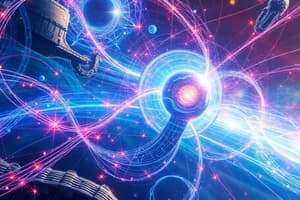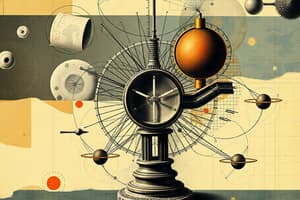Podcast
Questions and Answers
What is the relationship described by Newton's second law of motion?
What is the relationship described by Newton's second law of motion?
- For every action, there is an equal and opposite reaction.
- An object at rest remains at rest unless a force is applied.
- Force equals mass times acceleration. (correct)
- An object in motion will remain in motion unless acted upon.
Which of the following correctly represents kinetic energy?
Which of the following correctly represents kinetic energy?
- Work = Force × Distance
- Potential Energy = mgh
- Power = Work × Time
- Kinetic Energy = 0.5 × m × v² (correct)
According to the laws of thermodynamics, what can be said about energy?
According to the laws of thermodynamics, what can be said about energy?
- Energy is always lost in a closed system.
- Energy can be created and destroyed.
- Energy can only be transferred through radiation.
- Energy cannot be created or destroyed. (correct)
What is Coulomb's Law primarily used to describe?
What is Coulomb's Law primarily used to describe?
Which phenomenon involves the bending of light when it passes from one medium to another?
Which phenomenon involves the bending of light when it passes from one medium to another?
What is the fundamental concept of wave-particle duality in quantum mechanics?
What is the fundamental concept of wave-particle duality in quantum mechanics?
What does special relativity primarily affect?
What does special relativity primarily affect?
Which of the following concepts explains the origin and evolution of the universe?
Which of the following concepts explains the origin and evolution of the universe?
Flashcards are hidden until you start studying
Study Notes
Key Concepts in Physics
-
Definitions and Branches
- Physics: Study of matter, energy, and their interactions.
- Classical Physics: Mechanics, thermodynamics, and electromagnetism.
- Modern Physics: Quantum mechanics and relativity.
-
Mechanics
- Newton's Laws of Motion:
- An object at rest stays at rest; an object in motion stays in motion unless acted upon.
- F=ma (Force equals mass times acceleration).
- For every action, there is an equal and opposite reaction.
- Kinematics: Study of motion (displacement, velocity, acceleration).
- Dynamics: Forces and their effects on motion.
- Work, Energy, and Power:
- Work = Force × Distance (in the direction of the force).
- Kinetic Energy = 0.5 × m × v².
- Potential Energy = mgh (mass × gravity × height).
- Power = Work/time.
- Newton's Laws of Motion:
-
Thermodynamics
- Laws of Thermodynamics:
- Energy cannot be created or destroyed (conservation of energy).
- Entropy of an isolated system always increases.
- Absolute zero is unattainable.
- Concepts: Heat, temperature, heat transfer (conduction, convection, radiation).
- Laws of Thermodynamics:
-
Electromagnetism
- Electric Forces and Fields: Coulomb’s Law, electric field (E = F/q).
- Magnetic Forces: Lorentz Force, magnetic field (B).
- Maxwell's Equations: Fundamental equations of electromagnetism.
- Electromagnetic Waves: Interaction of electric and magnetic fields.
-
Wave Phenomena
- Properties: Wavelength, frequency, amplitude, speed.
- Types of Waves: Mechanical and electromagnetic waves; longitudinal and transverse waves.
- Phenomena: Reflection, refraction, diffraction, interference.
-
Optics
- Reflection and Refraction: Laws of Snell, lens formulas.
- Optical Instruments: Cameras, microscopes, telescopes.
- Wave-Particle Duality: Light exhibits properties of both waves and particles.
-
Quantum Mechanics
- Fundamental Principles: Wave-particle duality, uncertainty principle.
- Quantum States: Superposition, entanglement.
- The Schrödinger Equation: Fundamental equation of wave mechanics.
-
Relativity
- Special Relativity: Time dilation, length contraction, mass-energy equivalence (E=mc²).
- General Relativity: Gravity as curvature of spacetime.
-
Astrophysics and Cosmology
- Structure of the Universe: Galaxies, stars, black holes.
- Big Bang Theory: Origin and evolution of the universe.
- Dark Matter and Dark Energy: Concepts explaining cosmic phenomena.
Important Equations
- Kinematics: ( v = u + at ), ( s = ut + \frac{1}{2}at^2 ), ( v^2 = u^2 + 2as )
- Work: ( W = F \cdot d )
- Energy Conservation: ( KE + PE = constant )
- Coulomb’s Law: ( F = k \frac{|q_1 q_2|}{r^2} )
- Ohm’s Law: ( V = IR ) (Voltage = Current × Resistance)
Study Tips
- Practice problem-solving: Work through numerical problems related to each topic.
- Visual aids: Use diagrams and graphs to understand concepts better.
- Concept mapping: Link different physics concepts to see connections.
- Review regularly: Spaced repetition for retention of key formulas and principles.
Definitions and Branches
- Physics studies matter, energy, and their interactions.
- Classical Physics focuses on mechanics, thermodynamics, and electromagnetism.
- Modern Physics deals with quantum mechanics and relativity.
Mechanics
- Newton's three laws of motion define how objects move in response to forces.
- Kinematics is the study of motion, including displacement, velocity, and acceleration.
- Dynamics examines forces and their effects on motion.
- Work, energy, and power are related concepts:
- Work is done when a force acts on an object over a distance.
- Kinetic energy is the energy of motion.
- Potential energy is stored energy due to position.
- Power is the rate at which work is done.
Thermodynamics
- The laws of thermodynamics govern energy transfer and transformation.
- They state that energy cannot be created or destroyed, entropy increases in isolated systems, and absolute zero is unattainable.
- Heat, temperature, and heat transfer (like conduction, convection, and radiation) are key concepts.
Electromagnetism
- Electric forces arise from interactions between charged objects, described by Coulomb's Law.
- An electric field influences charged objects.
- Magnetic forces occur between magnets and moving charges.
- Maxwell's equations provide a comprehensive understanding of electromagnetic phenomena.
- Electromagnetic waves are created by the interaction of electric and magnetic fields.
Wave Phenomena
- Waves transfer energy without transferring matter.
- Key properties include wavelength, frequency, amplitude, and speed.
- Waves can be mechanical (like sound waves) or electromagnetic (like light).
- Phenomena like reflection, refraction, diffraction, and interference demonstrate wave behavior.
Optics
- Reflection and refraction are the bending of light as it bounces off or passes through different media.
- Optical instruments like cameras, microscopes, and telescopes use lenses and mirrors to manipulate light.
- Light exhibits both wave and particle properties, known as wave-particle duality.
Quantum Mechanics
- Wave-particle duality is a fundamental principle, showing light's ability to act as both a wave and a particle.
- The uncertainty principle states that it's impossible to know both a particle's position and momentum with perfect accuracy.
- Superposition and entanglement are quantum phenomena describing the unique states of quantum systems.
- The Schrödinger Equation is a key equation in wave mechanics, describing how quantum systems evolve over time.
Relativity
- Special relativity deals with the relationship between space and time, including effects like time dilation, length contraction, and the mass-energy equivalence (E=mc²).
- General relativity explains gravity as a curvature of spacetime caused by mass and energy.
Astrophysics and Cosmology
- The universe comprises galaxies, stars, and black holes.
- The Big Bang theory describes the origin and evolution of the universe.
- Dark matter and dark energy are theoretical concepts that explain some observed cosmic phenomena.
Important Equations
- Kinematics:
- ( v = u + at ) (final velocity = initial velocity + acceleration × time)
- ( s = ut + \frac{1}{2}at^2 ) (displacement = initial velocity × time + 0.5 × acceleration × time²)
- ( v^2 = u^2 + 2as \ ) (final velocity² = initial velocity² + 2 × acceleration × displacement)
- Work: ( W = F \cdot d ) (work = force × distance)
- Energy Conservation: ( KE + PE = constant ) (kinetic energy + potential energy = a constant)
- Coulomb’s Law: ( F = k \frac{|q_1 q_2|}{r^2} ) (force between charges = constant × magnitude of charge 1 × magnitude of charge 2 / distance²)
- Ohm’s Law: ( V = IR ) (voltage = current × resistance)
Study Tips
- Practice problems: Work through numerical problems to apply concepts.
- Use diagrams and graphs for visual comprehension.
- Create concept maps to link different concepts and see connections.
- Review regularly for better retention.
Studying That Suits You
Use AI to generate personalized quizzes and flashcards to suit your learning preferences.




